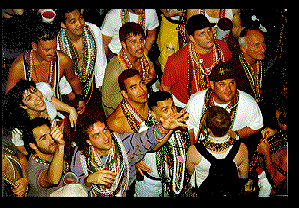Every year, New Orleans shuts down and throws the party of parties. Everywhere else in the country, it's just another Tuesday. But, in New Orleans it's the Mardi Gras !
Mardi Gras is more than a single day of celebration. It's a state of mind. Mardi Gras reflects and defines the cultural traditions of New Orleans.
Most "outsiders" assume Mardi Gras takes place on a single day. This is true. Mardi Gras is French for Fat Tuesday. Some time ago, the tradition was to slaughter a fatted calf on the Tuesday before the beginning of the Lenten 40 day fast. Thus, the coining of the phrase "Fat Tuesday."
There is a distinction, however, between Mardi Gras and Carnival. Mardi Gras is a single day that is the climax for the Carnival season. The Carnival season begins on January 6th or Twelfth Night (Kings Night) and runs until the beginning of Lent- the Easter season (Ash Wednesday). Carnival can run as long as two months, depending on the church calendar.
Mardi Gras day or Fat Tuesday is the traditional day for masking. However, you'll find people enjoying this tradition beginning the Friday before Mardi Gras day. Mardi Gras costumes are elaborate. Sequins and feathers rule the day. Families and friends often mask as a group. It's not unusual to see a marching box of Crayola Crayons or a studly herd of bare chested firemen carrying a ten foot hose. Anything goes on Mardi Gras day. However, the obscenity laws are still on the books. Although, it's amazing what people get
away with wearing or, should I say, NOT wearing.
The French Quarter is often called the "adult" Mardi Gras. Costumes can be more than revealing and there are some Carnival traditions (i.e. The chant "Show me your "insert preferred body part here" !) that would land a person in jail on any other day of the year. Police tend to look the other way at most of the stuff that goes on Mardi Gras day.
The lower French Quarter is the center for Gay Mardi Gras. This is where you'll find the more extravagant costumes. People come from all over the world just to strut around in costumes of their own design. Of course, going home with a prestigious Bourbon Street Award is often the motivation for their sequined madness.
Although parades roll for weeks before Fat Tuesday, on the Day of Days - parades begin early in the morning with the ever popular Zulu and don't stop until the last float passes late in the night. The highlight of the parades is the toast between the King of Carnival - Rex - and the mayor of New Orleans. This is the official proclamation and beginning of Mardi Gras. During thhe toast, Rex gives all city workers the day off and commands everyone to have a good time.
The Carnival season is the highlight of the New Orleans social calendar. The season officially begins on Twelfth Night or "Kings Night." Many New Orleanians with artificial Christmas trees will leave them up and replace the Christmas decor with purple, gold and green ornaments. These are the official colors of Carnival. Legend has it that these colors represent - green for faith, gold for power and purple for justice. However, most people believe these colors were chosen, simply, because they look good together.
Another Carnival tradition that begins on Twelfth Night is the King Cake. A King Cake is a round cake decorated with sweet purple, gold and green frosting. In every King Cake there is a little plastic baby representing the baby Jesus. The person who is lucky enough to bite into the piece of King Cake with the plastic baby gets to buy the next King Cake for the next King Cake party.
During the Carnival season, Mardi Gras Krewes , local clubs that sponsor parades and Carnival events, hold elaborate Balls and parties where their King, Queen and other Royalty are announced for the year. On its surface, the election of Royalty may seem comical. However, being chosen is a very special honor and is taken very seriously by New Orleanians. Mardi Gras Royalty are elected because of their contributions and standing in the community. Being chosen to represent a Krewe as a King or Queen is an honor that announces to the community at large that these people have made our city a better place and we recognize their hard work and dedication. So, be sure to raise your cup and toast every King and Queen !
If you don't live in New Orleans, it is impossible to understand all the planning, hard work and expense that go into Carnival. Most Krewes begin planning for Carnival a year or more in advance. People belonging to a Krewe pay dues and spend their own money to stage their parades and to buy throws. This is not an inexpensive venture. The average Mardi Gras Krewe spends hundreds of thousands of dollars and countless hours of donated time to parade for just a few hours. Why do it ? New Orleanians love their city
and you just have to ride in a Mardi Gras parade to understand the thrill of throwing stuff to a hungry crowd.
Although every King and Queen deserve respect, the true King of Carnival is Rex. The identity of Rex is a secret until the day before Mardi Gras. People anxiously await the announcement of the King of Carnival. Being chosen as the King of Rex is the highest honor New Orleans can bestow. The King of Rex is chosen because of his prominent standing in the community. It's a really big deal.
The Queen of Rex is always a young debutante. It's all very aristocratic. Carnival officially ends when the King and Queen of Rex meet, at midnight on Fat Tuesday, the Queen and King of Comus. When they meet, the traditional "Whenever I Cease To Love" theme is played and true New Orleanians eyes fill with tears from memories of Mardi Gras past and the fact that they have to wait another year to have this much fun.
Once the Royalty of Comus and Rex meet, police take to the street on horseback - followed by street sweepers - announcing that Mardi Gras is over and people should "clear the streets." By this time, most people have had enough and are ready to rest. As soon as the last parade passes, the city begins the incredible task of cleaning up. All the garbage is weighed and this is how New Orleans estimates how many people came to Mardi Gras.
How Mardi Gras started is not really clear. There are plenty of legends and stories about early Carnival. But, it's not certain which are myth and which are fact.
Legend has it that the first Mardi Gras came to be because the early Christian church adopted and reformed the Roman feast of Lupercalia, a decadent three days of celebration, in order to convert the pagans. The early Church renamed the holiday to "carnelevamen," meaning "farewell to the flesh."
The French coined the phrase Mardi Gras, which means Fat Tuesday , and brought the holiday with them when they settled New Orleans. In fact, in 1699 the French-Canadian explorer Pierre Le Moyne, Sieur d'Iberville landed near the mouth of the Mississippi River on Mardi Gras Day and named the plot of ground "Pointe du Mardi Gras."
Early Mardi Gras was not an organized, community event. The holiday was basically celebrated by throwing private, wild parties. After all, New Orleans was and still is a port city - and you know those sailors !
On February 24th, 1857, Mardi Gras was changed forever. This was the year that the first true Mardi Gras Krewe was formed. The club called themselves the Mystick Krewe of Comus, after the Greek god of revelry. Comus began the tradition of the elaborate Ball and Carnival parade.
Over the years, many more Krewes were founded. It wasn't until the 1950's, however, that the Mardi Gras we know today came into fruition.
Probably as a result of the post-war baby boom, many more Carnival Krewes were formed in the fifties and sixties. Ask any local and they're bound to have fond memories of riding on a float with their family. Mardi Gras became a holiday for families to celebrate and spend time with each other. Today, Mardi Gras remains a time to gather with family and friends. In fact, people are expected to open their homes to friends and family if they live within walking distance of the parades.
In New Orleans, the more family oriented Carnival has moved into the suburb of Metairie. The rise in the number of Krewes and the population shift to the suburbs has created, really, two distinct Carnival traditions. Parades roll in New Orleans and in Metairie.
The parades that roll in New Orleans are either "old line" krewes like Rex or, what have come to be known as, "superkrewes." The "superkrewes" began in 1969 with the founding of Bacchus- named for thegod of wine. The city was stunned by the enormous floats designed by Blaine Kern (now a world famous designer of floats and other ornaments). In addition, this Krewe allowed anyone who paid dues to be a member. It didn't matter if you could trace your ancestry back to the buccaneers. The first King of Bacchus broke the most serious tradition. The King wasn't a community leader but Danny Kaye, a Hollywood star.
Today, Bacchus has become one of the largest and best parades in New Orleans and rolls the Sunday before Mardi Gras. Every year a different celebrity is made King and rides a special float. Last year, Jean-Claude Van Damme rode as King. This year John Larroquette (Night Court), a New Orleans native, will ride as Royalty.
The founding of Bacchus started a new tradition. Soon after the debut of this incredible parade, other superkrewes were founded. Endymion, which rolls on the Saturday night before Mardi Gras, was established in 1974. Endymion throws a party called the "Extravaganza" and tickets to this event are cherished and hard to come by. The Extravaganza is a party held in the Superdome for some 10,000 people. Entertainment is provided by some of the top names in the business. In 1995, the 1,500 member Krewe of Endymion introduced the largest Mardi Gras float ever ! With the theme Welcome To The New Orleans Mardi Gras this float rolled with 150 maskers on board.
In 1994, Harry Connick Jr., a national celebrity and New Orleans native, began a new superkrewe called Orpheus that rolls on Lundi Gras - the Monday before Fat Tuesday. This Krewe is destined to become one of New Orleans favorites.
In Metairie, the krewes that parade are usually groups of people that started clubs for their families. The parades in Metairie have become more sophisticated and larger over the years and some of them rival the best New Orleans parade. However, most of the parades in Metairie rent their floats and you tend to see the same floats (modified a little) rolling night after night. But, if you want to keep away from the more rowdy New Orleans crowd, Metairie is a nice alternative.
The traditions of Gay Mardi Gras came into being in the 1950s. The first Gay Mardi Gras Krewe was the Krewe of Yuga or "KY." This Krewe was formed to satirize the straight, aristocratic Mardi Gras traditions in 1958. In 1962, the Krewe of Yuga threw its first Ball at a badly chosen sight, a private children's school. No sooner had the tableau begun with Queen and Maids expectantly waiting the adoration of the spectators when police cars roared up and the ball was raided. Doors were locked and people were
unceremoniously hauled to jail.
Taking a deep breath, the Gay community soon reorganized and new Gay Mardi Gras Krewes began to flourish. Peaking in the early 1980s, there were dozens of Gay Krewes that were the highlight of the Carnival season. Local matrons would beg for tickets from their hairdresser. They were quite the event.
The Gay balls required formal attire and the tableaus were a sight to behold. Many a cocktailed queen was seen to fall over from the weight of a bigger than life costume. It was all wonderful. My most cherished Carnival memories.
Why past tense? Today, there are only four Gay Krewes left- Amon Ra, Petronias, Armenius and the Lords of Leather. AIDS has taken many of the best and most talented people from New Orleans. It would be easy to blame a weak economy and apathy for the decline of the Gay krewes. It's not that. It was AIDS that destroyed this fine tradition.
Although there are only a few Gay Krewes left. These balls carry on the tradition for everyone. See the schedule of events for information about the Balls. Attire is formal and the balls are invitation only.
One Gay tradition that flourishes and attracts participants and an audience from across the globe is the Bourbon Street Awards. This year will mark the 35th anniversary of the Bourbon Street Awards. Sponsored by Wood Enterprises, these awards are the highlight of Gay Carnival.
The Bourbon Street Awards were originally held in front of Lafitte's on Bourbon Street until the crowd became so huge that the city asked them to move to a location with more "breathing room." Today, the Awards are held in front of the Rawhide on St. Ann and Burgundy in front of the Rawhide and begin at 12 noon (give or take an hour)!
Although the Bourbon Street Awards are presented and judged by celebrities, the true stars of the show are the costumed participants. The Bourbon Street Awards have become a solid New Orleans tradition and have been featured in documentaries and movies filmed by countries from across the world.
You can't miss the Bourbon Street Awards. If you do, you've missed a whole lot. Have plenty of film. Burgundy and St. Ann is the perfect place to get those shocking and fabulous Mardi Gras poses with the most animated people wearing the best costumes ever made. It's amazing.
And at 1pm every Mardi Gras, revelers head on over to Ambush Headquarters, 828 Bourbon Street, for the annual Krewe of Queenateenas {KOQ} Bead Toss. Now in its 12th year, the bead toss is led by the KOQ's reigning King Cake Queen {KCQ}, complete with changing balcony theme. For the best pearls on Bourbon Street, you show, they throw!
Carnival has such a long tradition that I had a difficult time summarizing its long history. Hopefully, this article gave you some understanding of what Carnival is all about.
Brought to you by
Gay Mardi Gras History


![]()
![]()


Over 2 MILLION *hpm & 225,000 **uvpm
gay mardi gras | southern decadence | rainbow award | g. a. awards

gay america | gay bars | gay euro | gulf south directory
![]()
gay atlanta | gay new orleans | gay pensacola

gay south beach | gay texas
web rates | site stats
ambush mag rates
*hits per month **unique visitors per month
Copyright © 1996-1999 Ambush, Inc. All Rights Reserved ®
THE WEB TEAM:
Rip Naquin-Delain | Sonny Cleveland | George Patterson
828-A Bourbon Street, New Orleans, Louisiana, 70116-3137, USA
PH 1.504.522.8047 FAX 1.504.522.0907